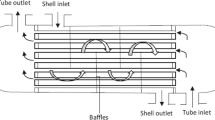Abstract
Multi-processor HPC tools have become commonplace in industry and research today. Evolutionary algorithms may be elegantly parallelized by broadcasting a whole population of designs to an array of processors in a computing cluster or grid. However, issues arise due to synchronization barriers: subsequent iterations have to wait for the successful execution of all jobs of the previous generation. When other users load a cluster or a grid, individual tasks may be delayed and some of them may never complete, slowing down and eventually blocking the optimization process. In this paper, we extend the recent “Futures” concept permitting the algorithm to circumvent such situations. The idea is to set the default values to the cost function values calculated using a high-quality surrogate model, progressively improving when “exact” numerical results are received. While waiting for the exact result, the algorithm continues using the approximation and when the data finally arrives, the surrogate model is updated. At convergence, the final result is not only an optimized set of designs, but also a surrogate model that is precise within the neighborhood of the optimal solution. We illustrate this approach with the cluster optimization of an A/C duct of a passenger car, using a refined CFD legacy software model along with an adaptive meta-model based on Proper Orthogonal Decomposition (POD) and diffuse approximation.













Similar content being viewed by others
References
Holland JH (1975) Adaptation in natural and artificial systems. University of Michigan Press, Ann Arbor
Vose MD (1999) The simple genetic algorithm: foundations and theory. MIT Press, Cambridge
Konak A, Coit DW, Smith AE (2006) Multi-objective optimization using genetic algorithms: a tutorial. Reliab Eng Syst Saf 91:992–1007
Deb K (2001) Multi-objective optimization using genetic algorithms. Wiley, Chichester
Willcox K, Peraire J (2002) Balanced model reduction via the proper orthogonal decomposition. AIAA Journal 40(11):2323–2330
Gorissen D, Couckuyt I, Laermans E, Dhaene T (1985) Multiobjective global surrogate modeling, dealing with the 5-percent problem. Eng Comput 26(1):81–98
Lim D, Jin YC, Ong YS, Sendhoff B (2010) Generalizing surrogate-assisted evolutionary computation. IEEE Trans Evol Comput 14(3):329–355
Quiepo NV, Verde A, Pintos S, Haftka RT (2009) Assessing the value of another cycle in Gaussian process surrogate-based optimization. Int J Struc Multidisc Optim 39(5):459–475
Viana FAC, Haftka RT, Steffen V (2009) Multiple surrogates: how cross-validation errors can help us to obtain the best predictor. Int J Struc Multidisc Optim 39(4):439–457
Knowles J (2006) ParEGO: a hybrid algorithm with on-line landscape approximation for expensive multi objective optimization problems. IEEE Trans Evol Comput 10(1):50–66
Jones D, Schonlau M, Welch W (1998) Efficient global optimization of expensive black-box functions. J Glob Optim 13:455–492
Berkooz G, Holmes P, Lumley JL (1993) The proper orthogonal decomposition in the analysis of turbulent flows. Annu Rev Fluid Mech 25:539–575
Filomeno Coelho R, Breitkopf P, Knopf-Lenoir C (2008) Model reduction for multidisciplinary optimization—application to a 2d wing. Int J Struc Multidisc Optim 37(1):29–48
Filomeno Coelho R, Breitkopf P, Knopf-Lenoir C (2009) Bi-level model reduction for coupled problems. Int J Struc Multidisc Optim 39(4):401–418
Xiao M, Breitkopf P, Coelho RF, Knopf-Lenoir C, Sidorkiewicsz M, Villon P (2009) Model reduction by CPOD and Kriging. Int J Struc Multidisc Optim 41(4):555–574
Bethke AD (1976) Comparison of genetic algorithms and gradient-based optimizers on parallel processors: efficiency of use of processing capacity, Tech rep no 197. University of Michigan, Ann Arbor
Greffensette JJ (1981) Parallel adaptive algorithms for function optimization: parallel subcomponent interaction in a multilocus model, Tech Rep No CS-81-19. Vanderbilt University, Nashville
Cantu-Paz E (1997) A survey of parallel genetic algorithms IllGAL report 97003. The University of Illinois, Chicago
Tsutsui S (2010) Parallelization of an evolutionary algorithm on a platform with multi-core processors. Artificial evolution, vol 5975. Lecture notes in computer science. Springer, Heidelberg, pp 61–73
Wu H, Xu CL, Zou XF (2009) An efficient asynchronous parallel evolutionary algorithm based on message passing model for solving complex nonlinear constrained optimization. In: proceedings of the 8th international symposium on operations research and its applications, ZhangJiaJie, China
Regis RG, Shoemaker CA (2009) Parallel stochastic global optimization using radial basis functions. INFORMS J Comput 21(3):411–426
Asouti VG, Kampolis IC, Giannakoglou KC (2009) A grid-enabled asynchronous meta model-assisted evolutionary algorithm for aerodynamic optimization. Genet Program Evolvable Mach 10(4):373–389
LeRiche R, Collette Y, Hansen N, Pujol G, Salazar D (2010) On object-oriented programming of optimizers: examples in Scilab. In: P. Breitkopf, R. Filomeno Coehlo (eds) Multidisciplinary design optimization in computational mechanics (chapter 14) Wiley/ISTE, Ney York, June 2010, pp 499–538
Caromel D, Henrio L (2004) A theory of distributed objects. Springer, Berlin
http://omd2.scilab.org/ (2009) OMD2-project home-page, Accessed Feb 22 2011
http://www.openfoam.com OpenFoam: the open-source CFD toolbox, Accessed Aug 17 2010
Breitkopf P (1998) An algorithm for construction of iso-valued surfaces for finite elements. Eng Comput 14(2):146–149
Rypl D, Krysl P (1997) Triangulation of 3D surfaces. Eng Comput 13(2):87–98
Breitkopf P, Rassineux A, Touzot G, Villon P (2000) Explicit form and efficient computation of MLS shape functions and their derivatives. Int J Numer Meth Eng 48:451–456
Ryckelynck D (2005) A priori hyper eduction method: an adaptive approach. J Comput Phys 202(1):346–366
Acknowledgments
This work has been supported by the French National Research Agency (ANR), through the COSINUS program (project OMD2 no. ANR-08-COSI-007). The authors acknowledge the Projet Pluri-Formations PILCAM2 at the Université de Technologie de Compiègne for providing HPC resources that have contributed to the research results reported within this paper (URL: http://pilcam2.wikispaces.com.) as well as Maryan Sidorkiewicsz, Direction de la Recherche, Renault, France and Mr. V. Picheny, Ecole des Mines, France for contributing the CFD model used in this work.
Author information
Authors and Affiliations
Corresponding author
Rights and permissions
About this article
Cite this article
Raghavan, B., Breitkopf, P. Asynchronous evolutionary shape optimization based on high-quality surrogates: application to an air-conditioning duct. Engineering with Computers 29, 467–476 (2013). https://doi.org/10.1007/s00366-012-0263-0
Received:
Accepted:
Published:
Issue Date:
DOI: https://doi.org/10.1007/s00366-012-0263-0




